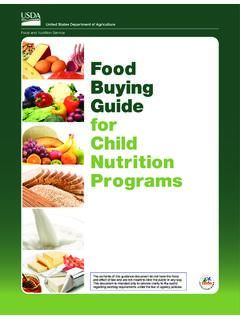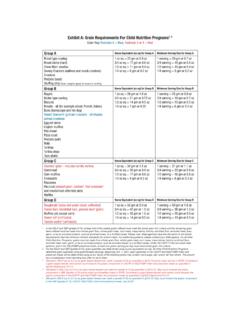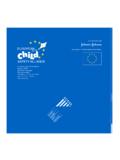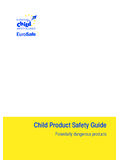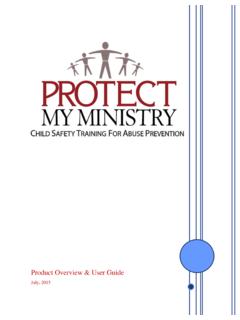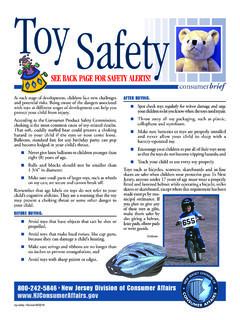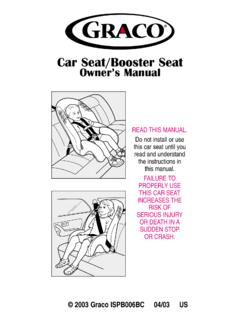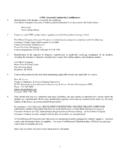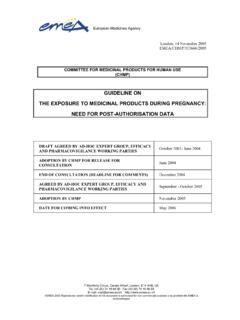Transcription of Food Buying Guide for Child Nutrition Programs
1 1 Meats / Meat Alternates Food Buying Guide for Child Nutrition Programs 1 Meats/Meat Alternates 1-1 1- 2 Food Buying Guide for Child Nutrition Programs 1 Meats/Meat Alternates Meats/Meat Alternates Component for the Child Nutrition Programs Child Nutrition Program regulations require all schools, centers, and day care homes participating in the National School Lunch Program (NSLP), National School Breakfast Program (SBP), Child and Adult Care Food Program (CACFP), and Summer Food Service Program (SFSP) to follow a food-based menu planning (FBMP) approach. FBMP helps Program operators serve cost-effective meals that are varied, balanced, safe, wholesome, and health promoting. Meats and meat alternates (M/MA) include meat, poultry, fsh, cheese, yogurt, soy yogurt, dry beans and peas, whole eggs, tofu, tempeh, peanut butter or other nut or seed butters, and nuts and seeds.
2 Child Nutrition Program operators must serve meals that contain the amount of M/MA required in the lunch and supper Meal Pattern Charts as shown on pages I-7 to I-17. Program operators have the choice to serve a M/MA as one of the two components of a snack served in the NSLP, CACFP, or as part of the breakfast for the SBP and CACFP. For the NSLP and SFSP, enriched macaroni-type products with fortifed protein as defned in 7 CFR Part 210 Appendix A, may be counted as meeting part of the M/MA requirement. Products formulated with alternate protein products may be counted as meeting all or part of the meats/meat alternates requirement for all Child Nutrition Programs . Noodles made from bean or legume fours may credit toward the meat/meat alternate component when paired with another meat/meat alternate, such as meat or cheese.
3 Yield data for bean four is listed in Appendix C of the Food Buying Guide . Dried and semi-dried meat, poultry and seafood products may be served in CNPs as part of a reimbursable meal or snack; however, these types of products ( , dried meat sticks) are not listed in the Food Buying Guide , as there is no standard yield data for these food items and the product formulations vary widely. Therefore, the meats/meat alternates contribution is based on the amount of meat, poultry, or seafood these products contain and the contribution is limited by the portion size. This is true of all food contributions with the exception of tomato paste, tomato puree, and dried fruit. A Child Nutrition (CN) label or a manufacturer s product Formulation Statement (PFS) must be used as documentation for dried meat, poultry, and seafood products.
4 When a PFS is provided for a dried meat, poultry, or seafood product , it should be evaluated to ensure the following crediting principles are followed: The creditable meat ingredient listed on the PFS must match or have a similar description as the ingredient listed on the product label ( , ground beef, no more than 30% fat). The creditable meat ingredient listed on the PFS must have a similar description to the food item in this Food Buying Guide . The creditable amount cannot exceed the fnished weight of the product . For detailed information and assistance on the proper use of these products, please contact your State agency. The M/MA for the lunch or supper must be served in the main dish or in the main dish and one other menu 3 In order for a food to contribute to the M/MA component, it must contain a minimum of oz of a M/MA.
5 For the SBP, M/MA can be an extra food, not a component for a reimbursable meal, or it may credit toward the required weekly total grains, only after meeting the daily grains requirement. For the CACFP, M/MA may be served in place of the entire grains component at breakfast a maximum of three times per Best Practices for All Child Nutrition Programs To further strengthen the nutritional quality of meals served, Program operators are encouraged, but not required, to: Serve a variety of lean protein foods, including seafood, lean meats and poultry, eggs, legumes (beans and peas), and nuts, seeds, and soy products, such as tempeh or tofu. Limit serving processed meats and poultry as they are typically sources of sodium and saturated fats. According to Dietary Guidelines for Americans (DGAs), processed meats are products preserved by smoking, curing, salting, and/or the addition of chemical preservatives.
6 Serve only natural cheeses and choose low-fat or reduced-fat section contains yield data for: Fresh and frozen boneless meat, poultry, and fsh in servings of 1 and 1-1/2 oz equivalent; Surimi seafood in servings of 1/4 oz, 1-oz, and 1-1/2 oz equivalent; Some fresh and frozen meats, poultry, and fsh with bones ( , chicken drumstick) in servings of 1 and 1-1/2 oz equivalent; Commercially prepared tofu in a serving of 1 oz equivalent for the NSLP, SBP, and CACFP; Tempeh in a serving of 1 oz equivalent; Peanut butter and other nut butters in 2 Tbsp and 3 Tbsp measures that are equivalent to 1 and 1-1/2 oz of meat alternate respectively; Whole eggs are expressed in large egg equivalents (1 large egg = 2 oz equivalent meat alternate) and 1/2 large egg equivalent (1/2 large egg = 1 oz equivalent meat alternate); USDA Foods or Market pack is listed in column 1.
7 For items where the USDA Foods and Market pack are both available, the items are designated as Includes USDA Foods ; Commercially-prepared combination foods that meet USDA, Food safety and Inspection Service (FSIS) standards that require a minimum percent of meat or poultry. Products listed include canned and frozen meat and poultry products at portion sizes to provide at least 1 ounce equivalent of cooked meat or poultry per average-size serving; Cooked dry beans and peas in servings of 1/4 cup and 3/8 cup (1 and 1-1/2 oz equivalent meat alternate respectively); and Standard commercially prepared canned bean or pea soups where one 1/2 cup serving provides 1/4 cup cooked beans (1 oz equivalent meat alternate). Meats/Meat Alternates NOTE: Information for nonspecific products such as chicken, beef, or pork nuggets and patties, and dried and semi-dried meat, poultry and seafood products is not provided in this Food Buying Guide .
8 Nonspecific products do not require a minimum amount of meat by FSIS labeling Standards of Identity. There is no general way to determine how much meat or poultry is contained in these products, especially since each manufacturer has its own formulation. Program operators using these products must either request the manufacturer to obtain a Child Nutrition label or request the manufacturer s documentation known as the product Formulation Statement to credit each specific product used. For more information on CN Labeling, please see Appendix C. Sample manufacturer s product Formulation Statement (PFS) templates may be accessed via the CN Labeling website at: 4 Food Buying Guide for Child Nutrition Programs1 Meats/Meat Alternates Defnitions A serving of cooked meat A serving of cooked meat is understood to be lean meat without bone.
9 According to Dietary Guidelines for Americans, lean meats and poultry contain less than 10 g of fat, g or less of saturated fats, and less than 95 mg of cholesterol per 100 g and per labeled serving size. A serving of cooked fresh orfrozen poultry A serving of cooked fresh or frozen poultry includes boneless meat and skin unless otherwise indicated. A serving of yogurt A serving of yogurt includes plain or favored, unsweetened or sweetened all types of yogurt must be commercially prepared and are further defned in the program regulations under 7 CFR parts , (bb), , and All yogurt served in the CACFP must contain no more than 23 grams of sugar per 6 ounces (7 CFR (a)(5)(iii)). Market pack Market pack refers to foods available on the market. IMPS IMPS stands for Institutional Meat Purchase Specifcations.
10 These specifcations describe in exact detail items most commonly used by foodservice establishments and institutional purchasers for purchasing meats. They are also used in USDA commodity specifcations. Only meats that are certifed by the USDA, Agricultural Marketing Service, Livestock, Poultry, and Seed Program (LPS) may be labeled IMPS. Like IMPS: Products having the description like IMPS imply that the IMPS standard for the described meat cut has been met but the meat has not been certifed by LPS; hence, it is like or similar to IMPS meat but is not labeled as such. The data for the products contained in the FBG was derived using certifed IMPS meat, but meats matching the descriptions and specifcations may use the FBG yield for the matching IMPS product . PFF PFF stands for Protein Fat Free, which is a procedure used by cured pork processors to refect the presence of added ingredients, including water in cured pork products, and relates labeling claims to the percent of meat protein in the product .
